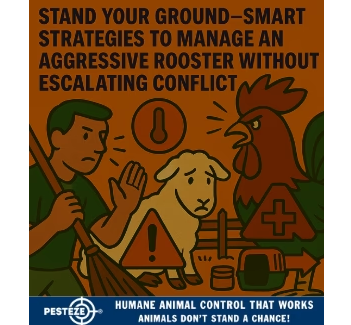MANAGING A ROOSTER THAT BECOMES AGGRESSIVE

MANAGING A ROOSTER THAT BECOMES AGGRESSIVE
SUMMARY
An aggressive rooster can disrupt your flock and pose safety risks to humans and hens alike. Whether it’s chasing, spurring, or guarding territory too fiercely, this guide helps you understand the behavior and apply humane, effective techniques to restore peace and control.
FEATURES
-
Understand the Triggers: Hormones, flock dynamics, and seasonal changes can fuel aggression.
-
Stay Calm and Confident: Roosters respond to energy—avoid panic and maintain steady posture.
-
Use Barriers and Tools: Employ brooms, boards, or buckets to redirect without physical contact.
-
Train with Positive Reinforcement: Reward calm behavior and discourage aggression through consistency.
-
Limit Access to Hens: Temporarily separating the rooster can reduce territorial dominance.
-
Know When to Rehome: If behavior doesn’t improve, consider relocating to a farm with fewer risks.
GUIDE DESCRIPTION
Roosters are natural protectors—but sometimes that instinct turns into aggression. Whether it’s charging at people, attacking hens, or guarding territory too fiercely, managing an aggressive rooster requires patience, awareness, and the right tools.
Aggression often spikes during mating season or when a rooster feels his dominance is challenged. Hormonal surges, new flock members, or even changes in routine can trigger defensive behavior. The first step is understanding what’s causing the aggression.
When interacting with an aggressive rooster, stay calm and assertive. Avoid running or flailing, which can escalate the situation. Instead, move slowly and confidently. Roosters read body language, and a steady presence can help de-escalate tension.
Use tools to create space. A broom, board, or even a bucket can help redirect the rooster without physical contact. Never strike or yell—this can worsen behavior and damage trust.
Training is possible. Use positive reinforcement to reward calm behavior. Treats, gentle voice commands, and consistent boundaries help reshape the rooster’s response over time. Avoid punishment, which often backfires.
If the rooster is overly dominant, consider limiting his access to hens. Separation for a few days can reduce hormonal intensity and give the flock a break. Reintroduce slowly and monitor behavior.
In some cases, rehoming may be the best option. If the rooster continues to pose a risk despite training, placing him in a less populated farm or with experienced handlers may be safer for everyone.
- Amy Chang


Comments 0